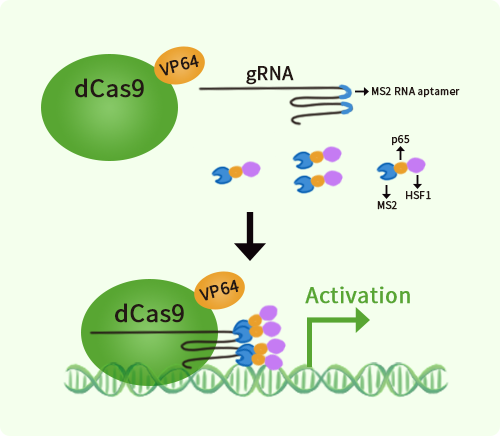Mouse Gpx2 activation kit by CRISPRa
CAT#: GA201714
Gpx2 CRISPRa kit - CRISPR gene activation of mouse glutathione peroxidase 2
Find the corresponding CRISPRi Inhibitor Kit
USD 1,290.00
2 Weeks*
Specifications
| Product Data | |
| Format | 3gRNAs, 1 scramble ctrl and 1 enhancer vector |
| Symbol | Gpx2 |
| Locus ID | 14776 |
| Kit Components | GA201714G1, Gpx2 gRNA vector 1 in pCas-Guide-CRISPRa GA201714G2, Gpx2 gRNA vector 2 in pCas-Guide-CRISPRa GA201714G3, Gpx2 gRNA vector 3 in pCas-Guide-CRISPRa 1 CRISPRa-Enhancer vector, SKU GE100056 1 CRISPRa scramble vector, SKU GE100058 |
| Disclaimer | The kit is designed based on the best knowledge of CRISPa SAM technology. The efficiency of the activation can be affected by many factors, including nucleosome occupancy status, chromatin structure and the gene expression level of the target, etc. |
| Reference Data | |
| RefSeq | NM_030677 |
| Synonyms | GI-GPx; GPx-GI; GSHPx-2; GSHPx-GI |
| Summary | The protein encoded by this gene belongs to the glutathione peroxidase family, members of which catalyze the reduction of organic hydroperoxides and hydrogen peroxide (H2O2) by glutathione, and thereby protect cells against oxidative damage. Several isozymes of this gene family exist in vertebrates, which vary in cellular location and substrate specificity. This isozyme is predominantly expressed in the gastrointestinal tract in rodents, is localized in the cytoplasm, and whose preferred substrate is hydrogen peroxide. Knockout studies in mice lacking this gene suggest a role for this isozyme in intestinal inflammation and colon cancer development. This isozyme is also a selenoprotein, containing the rare amino acid selenocysteine (Sec) at its active site. Sec is encoded by the UGA codon, which normally signals translation termination. The 3' UTRs of selenoprotein mRNAs contain a conserved stem-loop structure, designated the Sec insertion sequence (SECIS) element, that is necessary for the recognition of UGA as a Sec codon, rather than as a stop signal. A pseudogene of this locus has been identified on chromosome 7. [provided by RefSeq, Aug 2017] |
Documents
| Product Manuals |
| FAQs |
| SDS |
Resources
Other Versions
| SKU | Description | Size | Price |
|---|---|---|---|
| KN507287 | Gpx2 - KN2.0, Mouse gene knockout kit via CRISPR, non-homology mediated. |
USD 1,290.00 |
{0} Product Review(s)
Be the first one to submit a review






























































































































































































































































 Germany
Germany
 Japan
Japan
 United Kingdom
United Kingdom
 China
China
